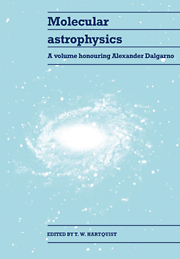Book contents
- Frontmatter
- Contents
- Dedication
- Preface
- Part I Molecular clouds and the distribution of molecules in the Milky Way and other galaxies
- Part II Diffuse molecular clouds
- Part III Quiescent dense clouds
- Part IV Studies of molecular processes
- Part V Atomic species in dense clouds
- Part VI H2 in regions of massive star formation
- 19 Infrared observations of line emission from molecular hydrogen
- 20 Shocks in dense molecular clouds
- 21 Dissociative shocks
- 22 Infrared molecular hydrogen emission from interstellar photodissociation regions
- Part VII Molecules near stars and in stellar ejecta
- Part VIII Moderately ionized gas and chemistry at large redshifts
- Index
19 - Infrared observations of line emission from molecular hydrogen
Published online by Cambridge University Press: 10 December 2009
- Frontmatter
- Contents
- Dedication
- Preface
- Part I Molecular clouds and the distribution of molecules in the Milky Way and other galaxies
- Part II Diffuse molecular clouds
- Part III Quiescent dense clouds
- Part IV Studies of molecular processes
- Part V Atomic species in dense clouds
- Part VI H2 in regions of massive star formation
- 19 Infrared observations of line emission from molecular hydrogen
- 20 Shocks in dense molecular clouds
- 21 Dissociative shocks
- 22 Infrared molecular hydrogen emission from interstellar photodissociation regions
- Part VII Molecules near stars and in stellar ejecta
- Part VIII Moderately ionized gas and chemistry at large redshifts
- Index
Summary
Introduction
Observations of infrared line emission from molecular hydrogen in astronomical sources have gone from the novel to the commonplace in a time that is short relative to most timescales for the advancement of astrophysical knowledge. In the face of the current onslaught of observations of H2, it may seem surprising that only a dozen years ago, when the 2 µm lines were first detected, it is reported to have taken their discoverers several months to identify the emitting species. Excited H2 continues to be detected in new and surprising places. In the Galaxy, H2 line emission is found at interfaces between young stellar winds and the interstellar medium, where it first was discovered by Gautier et al. (1976), in reflection nebulae (Gatley et al. 1987), in supernova remnants (e.g., Burton et al. (1988)), even including the Crab Nebula (Graham, Wright, and Longmore 1989), in planetary and proto-planetary nebulae (Treffers et al. 1976), and in the nucleus (Gatley et al. 1984). Beyond the Galaxy H2 line emission is found in Seyfert, as well as starburst galaxies (Thompson, Lebofsky, and Rieke 1978, Joseph et al. 1986, Fischer et al. 1987), in individual HII regions of normal spiral galaxies (Israel et al. 1989), and in interacting and merging galaxies (e.g., Joseph et al. 1986). Closer to home, H2 line emission has been detected very recently in the aurora of Jupiter (Trafton et al. 1988). In all of these examples, because of the unique physical conditions which must be satisfied in order that its infrared line emission be detectable, H2 lines provide important information about environments that are difficult to study by other means.
- Type
- Chapter
- Information
- Molecular AstrophysicsA Volume Honouring Alexander Dalgarno, pp. 345 - 359Publisher: Cambridge University PressPrint publication year: 1990
- 7
- Cited by

